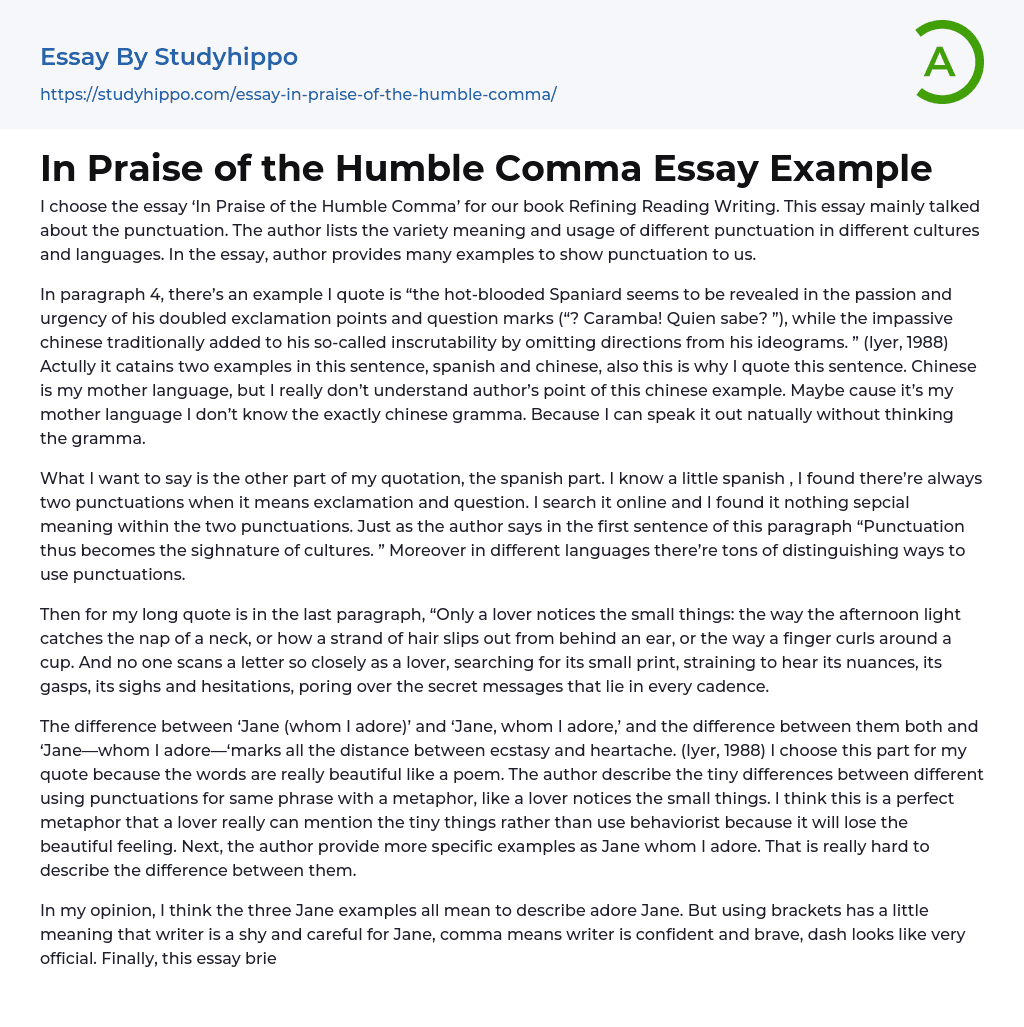I choose the essay ‘In Praise of the Humble Comma’ for our book Refining Reading Writing. This essay mainly talked about the punctuation. The author lists the variety meaning and usage of different punctuation in different cultures and languages. In the essay, author provides many examples to show punctuation to us.
In paragraph 4, there’s an example I quote is “the hot-blooded Spaniard seems to be revealed in the passion and urgency of his doubled exclamation points and question marks (“? Caramba! Quien sabe? ”), while the impassive chinese traditionally added to his so-called inscrutability by omitting directions from his ideograms. ” (Iyer, 1988) Actully it catains two examples in this sentence, spanish and chinese, also this is why I quote this sentence. Chinese is my mother language, but I really don�
...��t understand author’s point of this chinese example. Maybe cause it’s my mother language I don’t know the exactly chinese gramma. Because I can speak it out natually without thinking the gramma.
What I want to say is the other part of my quotation, the spanish part. I know a little spanish , I found there’re always two punctuations when it means exclamation and question. I search it online and I found it nothing sepcial meaning within the two punctuations. Just as the author says in the first sentence of this paragraph “Punctuation thus becomes the sighnature of cultures. ” Moreover in different languages there’re tons of distinguishing ways to use punctuations.
Then for my long quote is in the last paragraph, “Only a lover notices the small things: the way the afternoon light catches the nap of a
neck, or how a strand of hair slips out from behind an ear, or the way a finger curls around a cup. And no one scans a letter so closely as a lover, searching for its small print, straining to hear its nuances, its gasps, its sighs and hesitations, poring over the secret messages that lie in every cadence.
The difference between ‘Jane (whom I adore)’ and ‘Jane, whom I adore,’ and the difference between them both and ‘Jane—whom I adore—‘marks all the distance between ecstasy and heartache. (Iyer, 1988) I choose this part for my quote because the words are really beautiful like a poem. The author describe the tiny differences between different using punctuations for same phrase with a metaphor, like a lover notices the small things. I think this is a perfect metaphor that a lover really can mention the tiny things rather than use behaviorist because it will lose the beautiful feeling. Next, the author provide more specific examples as Jane whom I adore. That is really hard to describe the difference between them.
In my opinion, I think the three Jane examples all mean to describe adore Jane. But using brackets has a little meaning that writer is a shy and careful for Jane, comma means writer is confident and brave, dash looks like very official. Finally, this essay briefly talks about punctuation. Every punctuation has the meaning for existing itself. It can use to keep up law and order, and becomes a kind of special signature of cultures, also can be the rhythm and show our emotion. Moreover, you can analysis the punctuation to know the writers
temper.
In my opinion, punctuation is useful indeed and shows clues between the tiny differences, but I’m not professional on this part. For the signature of culture point I really agree with the author. Sometimes we can recognize the language just by the punctuation. Spanish is the fittest example, the double punctuation. And we all know punctuation can adjust the rhythm. Overall, I totally agree with the author though I don’t get all points, his examples and explanations really can convince me.
- Boo Radley essays
- Genesis essays
- Richard iii essays
- Alice in Wonderland essays
- On the road essays
- Ozymandias essays
- The Nightingale essays
- Holden Caulfield essays
- Animal Farm essays
- 1984 essays
- A Hanging essays
- Shooting An Elephant essays
- A Tale Of Two Cities essays
- Adventures Of Huckleberry Finn essays
- Arthur Conan Doyle essays
- Brave New World essays
- Characters In Hamlet essays
- Characters In Romeo And Juliet essays
- Desdemona essays
- Diary Of A Wimpy Kid essays
- First-Person Narrative essays
- Frankenstein essays
- Heart Of Darkness essays
- Jane Eyre essays
- Jay Gatsby essays
- King Duncan essays
- Librarian essays
- Little Red Riding Hood essays
- Lord Of The Flies essays
- Silas Marner essays
- The Cask Of Amontillado essays
- The Catcher In The Rye essays
- The Crucible essays
- The Handmaid's Tale essays
- The Reader essays
- Virgil essays
- Wuthering Heights essays
- Candide essays
- Castle essays
- J. D. Salinger essays
- Ulysses essays
- Ethan Frome essays
- In Cold Blood essays
- Outliers essays
- Tuesdays With Morrie essays
- The Art of War essays
- Wife of Bath essays
- Huckleberry Finn essays
- The Lady With The Dog essays
- Great Expectations essays




